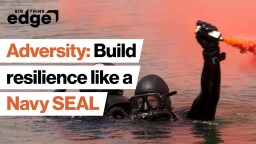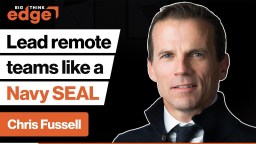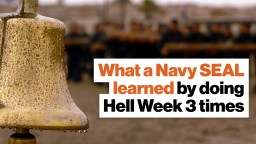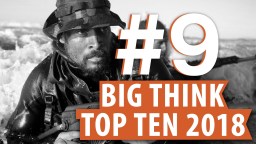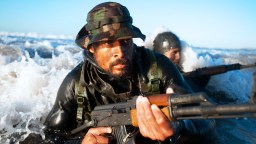Becoming a Navy SEAL isn’t exactly easy. First, you have to get through 18 months of training. About a month or so into that, you have to get through Hell Week. With an 80% attrition rate, Hell Week lives up to its name. But former Navy SEAL and current business consultant Brent Gleeson will tell you that the only way to get through it is similar to how teams of any kind get through hard times: by putting the team before the individual. Brent talks with us about his experience going through training, and the moment he realized that great teamwork — both in the business world and on the battlefield — is built on trust and respect. His new book is called TakingPoint: A Navy SEAL’s 10 Fail Safe Principles for Leading Through Change.
Brent Gleeson: When I think about how critical internal and external trust are to the success of any business organization I first go back to how important this principle was from day one of SEAL training.
We talk about discipline, we talk about trust, accountability, mental fortitude, but I had a unique experience happen to me, which is pretty rare during SEAL training.
SEAL training is 18 months long—very, very high attrition rate—for my class only about ten percent ultimately graduated of the original class.
But the first six months of that 18-month training pipeline is called BUDS, which stands for Basic Underwater Demolition SEAL.
And the first three weeks of BUDS are leading up to Hell Week. And those three weeks are no joke either; they’re just as bad as Hell Week, but you get to sleep a couple hours a night.
But then Hell Week is where you’re going to weed out the rest of your class.
By the end of Hell Week 80 percent of your class is gone, the rest will be dropped or rolled for performance issues or what not.
But one of the things that I write about in the book was the first time I learned about the pain of loss and sacrifice, and what I was really going to be experiencing as a member of Naval Special Warfare community. It was an interesting time because this was right before 9/11 so it was peacetime, but long story short we were in Hell Week.
Hell Week starts on a Sunday; ends on a Friday afternoon. And the great thing about that Sunday is the class will report to one of the main classrooms with only a couple required items in their possession and we don’t allow them to know when Hell Week will commence, when breakout starts, and it’s pure chaos; guys will quit minutes into breakout.
And so the anguish, the anxiety is just killing you. It’s a fascinating thing to watch—not a fascinating thing to be a part of.
So that afternoon our class leader, who was the highest ranking officer in the class, he read us—one of the things he did to motivate us was to read us the speech, the Saint Crispin’s Day Speech from William Shakespeare’s Henry V. And a great excerpt that many people know from that speech is, “We few, we happy few, we band of brothers: For he today that sheds his blood with me shall be my brother.”
John died four days later.
So we were four days into Hell Week, only about 30 of us left. We were in full gear, no fins, and in an Olympic sized swimming pool doing relay races, and we were performing an evolution called the Caterpillar Race, which is not as cute as it sounds. Your boat crew of seven guys will be in the water on your backs in a line swimming backwards like this, except my legs would be wrapped around the waist of the guy in front of me, his legs wrapped around the waist of the guy in front of him, and so on and so forth. And even fresh this is a very difficult evolution to execute properly and keep your head above water, much less beat the other boat crew to the other side of the pool. Everything in Hell Week is a race.
Four days into Hell Week you’re just a hallucinating blob of a person, so it's very... it’s hard to even keep your head above water.
Long story short, obviously those reports were not released, but he had a massive heart failure and drowned in the pool next to us. And we were all so out of it nobody knew what was really going on, so about a couple hours later they assembled us in the classroom and the commanding officer walks in, and he basically announces the passing of our class leader, immediately turned over command to the second highest ranking officer in the class—did it very candidly.
And then the next thing he said—I’ll never forget—he said, “Gentlemen, get used to this feeling that you have right now. This is what it’s going to be like in the teams. You are going to lose teammates. You have to learn to control your emotions. Stay focused on your mission objectives no matter what happens, and trust each other as a team.”
And of course time has passed and the emotion of the moment has caused me to forget his exact words, but he focused on the importance of team trust.
And when we think about that from an organizational standpoint one of the studies I focus on in the book is by Human Capital Institute; it was called Building Trust 2013: Workforce Trends Driving High Performance.
And a key data point—there are many—but a key data point that came from that survey was that employees, and this was employees from all over the world, different types of companies, employees in what they defined as “high performance organizations”, so companies that continue to generate positive financial returns and steady growth, those employees believed their leaders, managers and even their fellow peers to be highly trustworthy people.
So a culture where people walk the walk, they talk the talk, the leaders words match their actions consistently day in and day out, they live the values of the organization both on and off the battlefield so to speak.
And the area that trust effects most in an organization are productivity and employee engagement. And since we all know that employee engagement is a bit of a problem in today’s workforce one could theorize that trust is either non-valued, or more typically what I’ve seen is it’s just not properly managed and measured.
One of the interesting evolutions that the individual and the class goes through in the early stages of SEAL training is it goes from an individual sport—where you’re trying to be one of those small percentages of people that graduate—very quickly to a team sport—where you’re learning to work together as a team, you’re learning to have that team community, that bond and that shared sense of purpose, through shared values, that team ability so to speak to put the team before yourself.
One of our philosophies on the SEAL Teams—and this starts first week of BUDS through advanced training through team training—is we prioritize our readiness, and that is a team effort.
We have to rely on one another for that readiness because we have to, as a team, be able to execute anything at anytime around the world, and so readiness is our number one priority.
So let’s say it’s a training scenario, a real world mission after we do our after-action review and assess what went right, what went wrong, how we’re going to apply those lessons learned. We focus on team gear, then platoon or troop gear, and then our gear, and then and only then do we focus on ourselves: grabbing some food, taking a shower. You are the last priority.
And it’s a cultural ritual, a cultural experience that really instills that belief of readiness, that belief that the team comes before you and therefore you start to proactively take those actions that will get that result, the result being readiness.
And of course we can talk about teamwork or the importance of that, but the most important element of our culture is team.
We refer to as the Naval Special Warfare community as the teams.
We refer to each other as team guys. That is part of our culture. It is team first and nothing else. And people who don’t embody that mindset obviously don’t make it very far through training.
And that applies to any organization, really any relationship. A marriage, for example, is not a 50-50 thing, it’s a 100 percent-100 percent thing if you want it to be successful.
And in a business organization that will thrive and will grow you have that level of trust, that level of team-minded approach to every single thing you do.
People do not stay isolated and silo-ed in their lane, in their bunker—they cross barriers, they collaborate, they build organically cross-functional teams that allow the organization to be agile, to be dynamic, to be collaborative, to be communicative.
Those are the organizations that are resilient, that grow, that maintain a healthy financial status.
And it’s an easy correlation to draw between the SEAL Teams and our importance of teamwork and trust to fulfill our vision, just as it is to any organization that wants to compete and thrive in the 21st century.


